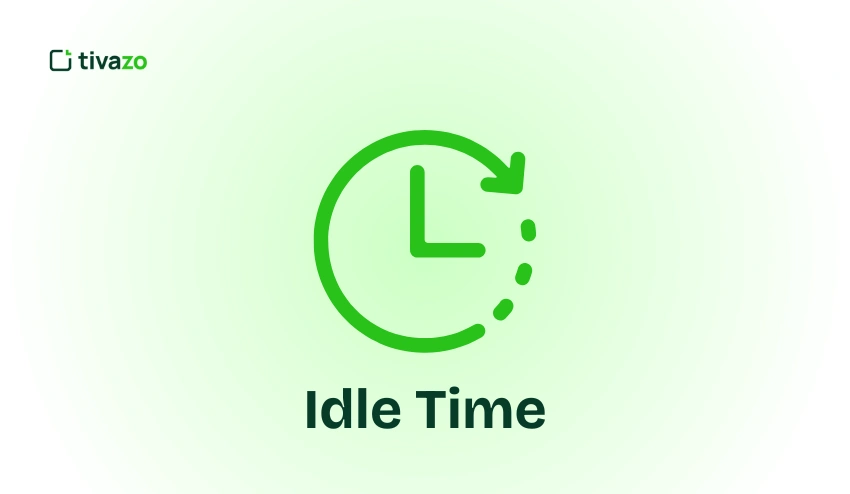In the modern hectic business environment, workforce planning has emerged as one of the current strategies of ensuring that organizations have the appropriate talent to achieve their objectives. Hiring employees when a job is available is no longer sufficient; businesses should have a long-term, strategic method of employing employees in the right position at the right time.
This article will explore the concept of workforce planning and its importance in detail, as well as how it can be used by businesses in order to achieve growth and prosperity in 2026 and beyond.
Key Highlights:
- Why Workforce Planning Matters
- Types of Workforce Planning
- 5-Step Planning Process
- Tools and Technologies
- Workforce Planning Templates and ROI Calculator
- Best Practices and Common Pitfalls
- Workforce Planning vs Workforce Management
Why Workforce Planning Matters in 2026
Due to the accelerated technological changes and market dynamics, workforce planning has been a crucial requirement in businesses. To sustain a competitive advantage, organisations must strategically align their workforce with future challenges and opportunities. In 2026, a powerful workforce planning strategy will be the key to long-term success.
1. Strategic Alignment and Growth Outcomes
The workforce planning aligns your workforce with the strategic objectives of your organization. With knowledge of future success, the businesses can be ready to grow, compete, and adapt to changing market needs.
2. Risk Reduction and Talent Continuity
Skill gaps may present serious risks as companies become bigger. Workforce planning assists in identifying these gaps at an early stage, thus companies can take measures to ensure that they are closed before it affect the performance. It can be retirements, resignations, or skills deficits, but with robust workforce planning, these risks are reduced.
3. Cost Optimization and Operational Resilience
Businesses can prevent over and under-hiring by predicting future success with the help of the talent that they need. Workforce planning is useful in maximizing staffing expenses through the recruitment of only the necessary amount of talent and the right people in the right positions.
Types of Workforce Planning
There are various types of workforce planning in that each type is designed to suit particular organizational requirements. The knowledge of such types will aid in customizing your planning endeavors to the goals of your business.
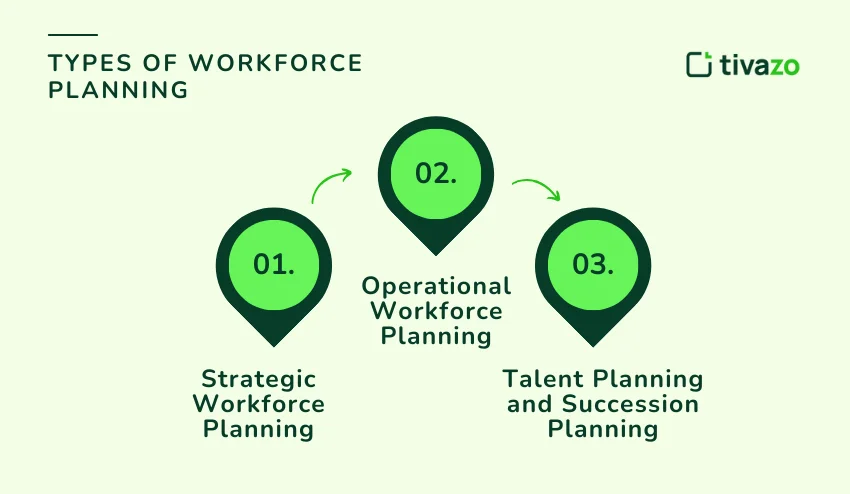
1. Strategic Workforce Planning
This kind is concerned with the long-term needs. It entails appreciation of the long-term objectives of the business and anticipation of what type of workforce management strategy will be necessary to achieve the objectives set. This involves the consideration of the trends such as technology adoption, market changes, and international growth.
- Example: Workforce planning will be required in an organization that intends to enter new markets, to determine the demand for local talents, leadership frameworks, and skills.
2. Operational Workforce Planning
Operational planning is also aimed at more short-term needs. This is concerning ensuring that there are the right number of employees that are available to undertake the day-to-day operations of the business. It is more operational and it handles workforce problems like employee turnover, time scheduling as well as projects that are temporary.
- Example: When a company anticipates demand peaks based on the season a workforce operational planning can make sure the workforce is capable of responding to the load.
3. Talent Planning and Succession Planning
Talent planning is concerned with ending the skill gaps, whereas succession planning is concerned with scouting the future leaders in the organization. These two domains tend to intersect but differ in their attention to the development of employees and their leadership succession.
- Example: An organization recognizes the high-potential individuals who can be used in leadership positions and at the same time, considers the skills gaps in terms of talent planning to facilitate a smooth transition of leadership.
The 5-Step Workforce Planning Process (How to Do It)
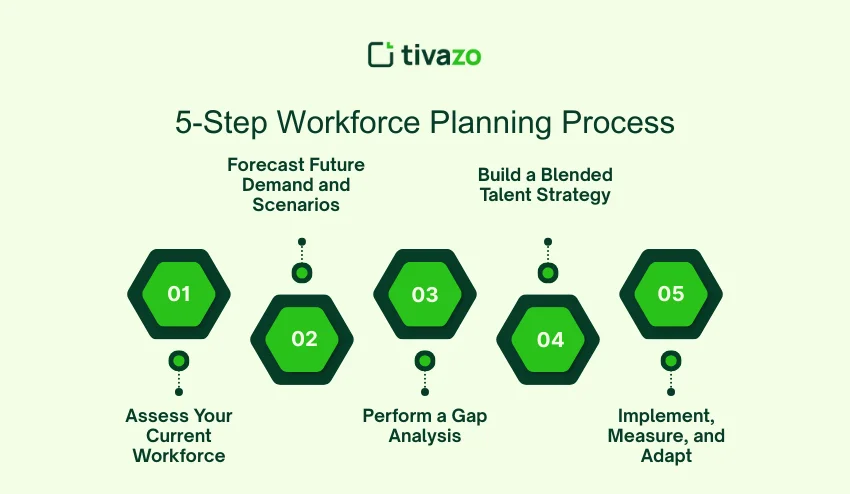
Step 1: Assess Your Current Workforce and Skills Inventory
Begin by examining your existing workforce, who they are, what skills they possess and where they may not match. Such tools as skills matrices can be used to map out the capabilities of employees. One must know the strengths and weaknesses of the people in the team and be able to strategize on the needs of the future.
Relate the data in the performance reviews and surveys to obtain a clear picture of the skill set of your employees.
Step 2: Forecast Future Demand and Scenarios
Take into account your business objectives and future projects or growths. What kind of talent will be required to meet these objectives? Anticipate the number of employees and the exact skills that will be needed within the next few months and years. Be in the lead, not only by keeping abreast of the present needs in the market, but also a possible future change in the market trends and technology.
Estimate the effect of various business conditions on staffing (e.g., rapid growth, economic downturn) by use scenario planning tools.
Step 3: Perform a Gap Analysis
It is time to now find out the gaps now that you know your current workforce and your future requirements. What skills are missing? What vacancies should be filled? By knowing the gap between the capability of your existing workforce and what your future hiring and training focus will require, you will have a clear goal with which your hiring and training can be focused.
Develop a visual skills gap chart that is useful in pinpointing key areas of need that should be upskilled or recruited as new staff.
Step 4: Build a Blended Talent Strategy
Develop strategies to address these gaps. This may involve recruiting new talent, retraining the current employees, or even automating some of the jobs. Take into account the cost and time of each alternative. Diversity in strategy offers flexibility and flexibility in the approach that you use to deal with the talent gaps.
Apply a decision matrix to decide whether it is cheaper to employ, train or automate certain functions.
Step 5: Implement, Measure, and Adapt
When the plan has been laid, put it into practice. The key performance indicators (KPIs) that can be used to monitor the results include the speed of hiring, employee retention, and productivity rates. As required change the plan to guarantee the long-term success. Evaluations and changes will be made as the workforce plan will be kept in line with the changing business requirements and the market dynamics.
Establish quarterly performance reviews to evaluate how well your workforce planning is performing and revise accordingly in response to your market.
Tools and Technologies for Workforce Planning
The effective use of the right workforce planning tools can make all the difference between a successful and a less successful planning process. These are used to predict demand, analyze the present workforce and computerize the gap analysis.
HR Analytics and Dashboards
These applications assist in gathering and processing information regarding your workforce and give you insights into productivity, performance and engagement. These data will be able to guide your workforce planning activities so that you can make better decisions.
- Important Tool: HR dashboards enable tracking the key metrics in real-time so that the HR managers can make more informed choices.
Scenario Planning and Forecasting Software
These tools assist companies in planning various possible futures so that they are able to be ready to both the eventualities of economic crises as well as the rapid expansion.
- Pro Tip: Be sure you use forecasting software that can integrate with the rest of the HR and business tools as this helps you to see the entire picture of future workforce requirements.
Talent Marketplaces and Internal Mobility Platforms
Internal mobility tools will facilitate internal mobility of employees in an organization, and this way you are not only recruiting outside, but also developing and promoting internally.
- Important Tool: Talent marketplaces are also able to match businesses with the freelance workers and it is now easier to fill temporary positions with specialized talent.
Workforce Planning Templates and ROI Calculator
Cost savings can also be attained in the business through proper workforce planning. This can be tracked by one of the ways of determining the ROI through an ROI calculator that is aimed at workforce planning. Businesses can also have a better idea of the financial outcomes of their planning efforts by determining the savings and cost of reduced hires, lower turnover, and better performance.
These calculations are useful in understanding how workforce planning may aid the bottom line so that businesses can justify the investments in workforce planning such as training, recruitment and technology. Monitoring ROI will help organizations to address the issue of ensuring that their workforce strategies are not only effective but also financially viable to make wiser decisions in the future.
Key Metrics to Track in Workforce Planning
It is also critical to monitor the appropriate metrics to determine the effectiveness of the workforce planning. Using critical data points, you are able to make sound changes to your workforce strategy.
Common Metrics in Workforce Planning:
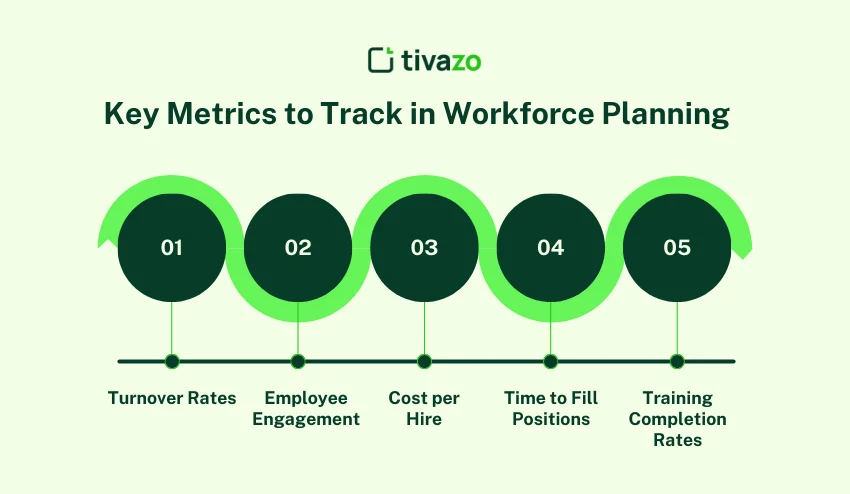
- Turnover Rates: When the turnover rates are followed it will determine whether you are retaining top talent or unnecessary turnover.
- Employee Engagement: This may show the level of alignment of your workforce to the company culture and objectives.
- Cost per Hire: This is a metric that will enable you to understand the effectiveness of the recruitment process.
- Time to Fill Positions: Helps allow you to monitor the speed at which you can fill open positions and stay productive.
- Training Completion Rates: The gauge of the level of employee upskilling and training initiatives.
Listening to these metrics, you may revise your workforce planning approach so that it could align to your objectives more closely.
Best Practices and Common Pitfalls in Workforce Planning
Effective workforce planning involves having a balance between foresight, flexibility and strategic decision making. The proper planning will be able to assist you in optimizing the staffing, cost reduction, and business growth. Nonetheless, some practices and pitfalls may or may not affect the effectiveness of your workforce strategy.
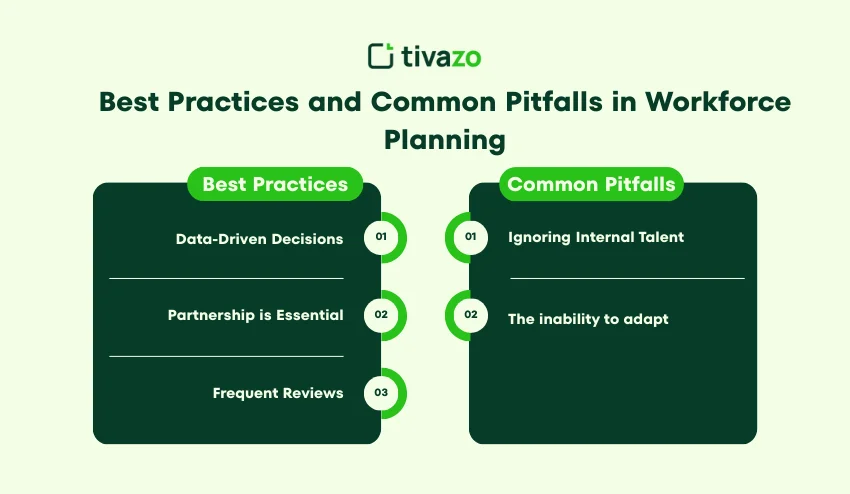
Best Practices
- Data-Driven Decisions: To plan, use data based on HR analytics, employee surveys and performance reviews.
- Partnership is Essential: Have all the departments on board such as HR, finance and operations, work together on workforce requirements.
- Frequent Reviews Workforce planning is not a one-off project but an adaptive process that takes place on the regular basis.
Common Pitfalls
- Ignoring Internal Talent: You may concentrate on recruiting new talent and miss the promise of your existing talent.
- The inability to adapt: Being stuck on an old strategy may result in missing an opportunity.
Workforce Planning vs Workforce Management: Quick Comparison Table
Whereas workforce planning is based on long-term objectives and strategy, day-to-day staffing requirements are managed by the workforce management. The two are critical to the success of the business, but target the different facets of optimization of the workforce.
| Aspect | Workforce Planning | Workforce Management |
|---|---|---|
| Focus | Long-term strategy and goal alignment | Day-to-day staffing and resource allocation |
| Goal | Achieve future business needs | Ensure smooth operations and productivity |
| Time Horizon | 1-3+ years | Weekly to quarterly |
| Key Tools | Forecasting software, HR analytics | Scheduling tools, time tracking systems |
Conclusion
A strategic workforce plan is one of the most important plans that businesses should have to be successful in 2026 and beyond. This can be done by matching your talent with corporate objectives, anticipating future requirements, bridging any skill shortage to make sure that your team is well equipped to handle the challenges in the future. It is a proactive strategy that not only reduces risks, but also costs and maximizes efficiency, making your business succeed in the long term.
Going forward, companies that invest in proper workforce planning will be agile enough to adjust to market changes. It is time to begin developing your workforce strategy; therefore, they can have the right people in the right place to propel growth and innovation in future years.

